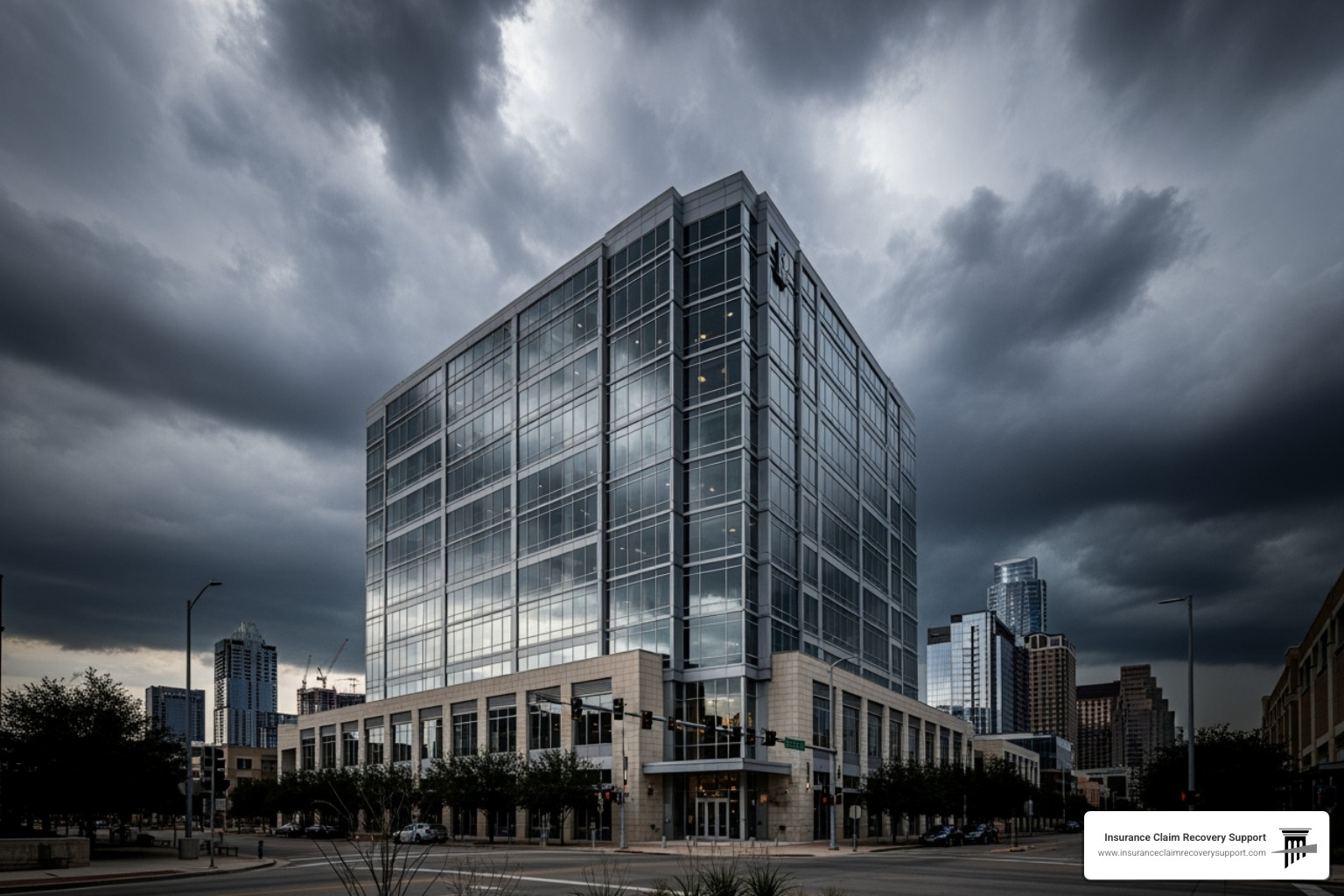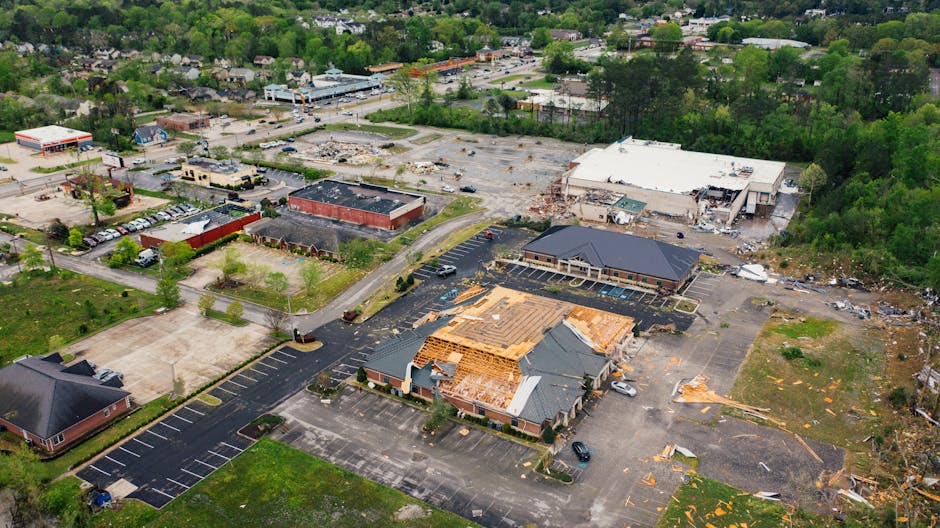What You Need to Know About Public Adjuster Income
Public adjuster income typically ranges from $61,000 to $104,000 per year, with an average of around $79,211 annually in 2025. This includes a base salary of approximately $68,829 plus additional compensation of about $10,381 through commissions and bonuses.
| Public Adjuster Income Breakdown | Amount |
|---|---|
| Average Annual Salary | $79,211 |
| Base Salary Component | $68,829 |
| Additional Compensation | $10,381 |
| Typical Fee Structure | 5-20% of claim settlement |
| Income Range | $61,000-$104,000 |
Public adjusters are licensed professionals who represent policyholders in insurance claims, working to maximize settlement amounts. Unlike insurance company adjusters who work for the insurer, public adjusters work exclusively for you, the policyholder. Their income structure directly aligns with your interests – they only get paid when you do, typically receiving a percentage of the final settlement.
The earning potential for public adjusters varies significantly based on several key factors:
- Experience level: More experienced adjusters can command higher fees
- Geographic location: Earnings vary by state and region
- Claim volume: Areas prone to natural disasters often yield higher income
- Fee structure: Usually 5-20% of the settlement amount
- State regulations: Some states cap fees (e.g., Texas at 10%)
Public adjusters handling large commercial claims or working in disaster-prone areas tend to earn substantially more than those focusing on smaller residential claims.
I’m Scott Friedson, CEO of Insurance Claim Recovery Support with experience in public adjuster income structures, having settled hundreds of millions in commercial and multifamily property damage claims while managing a team of adjusters whose income directly reflects their ability to maximize policyholder settlements.
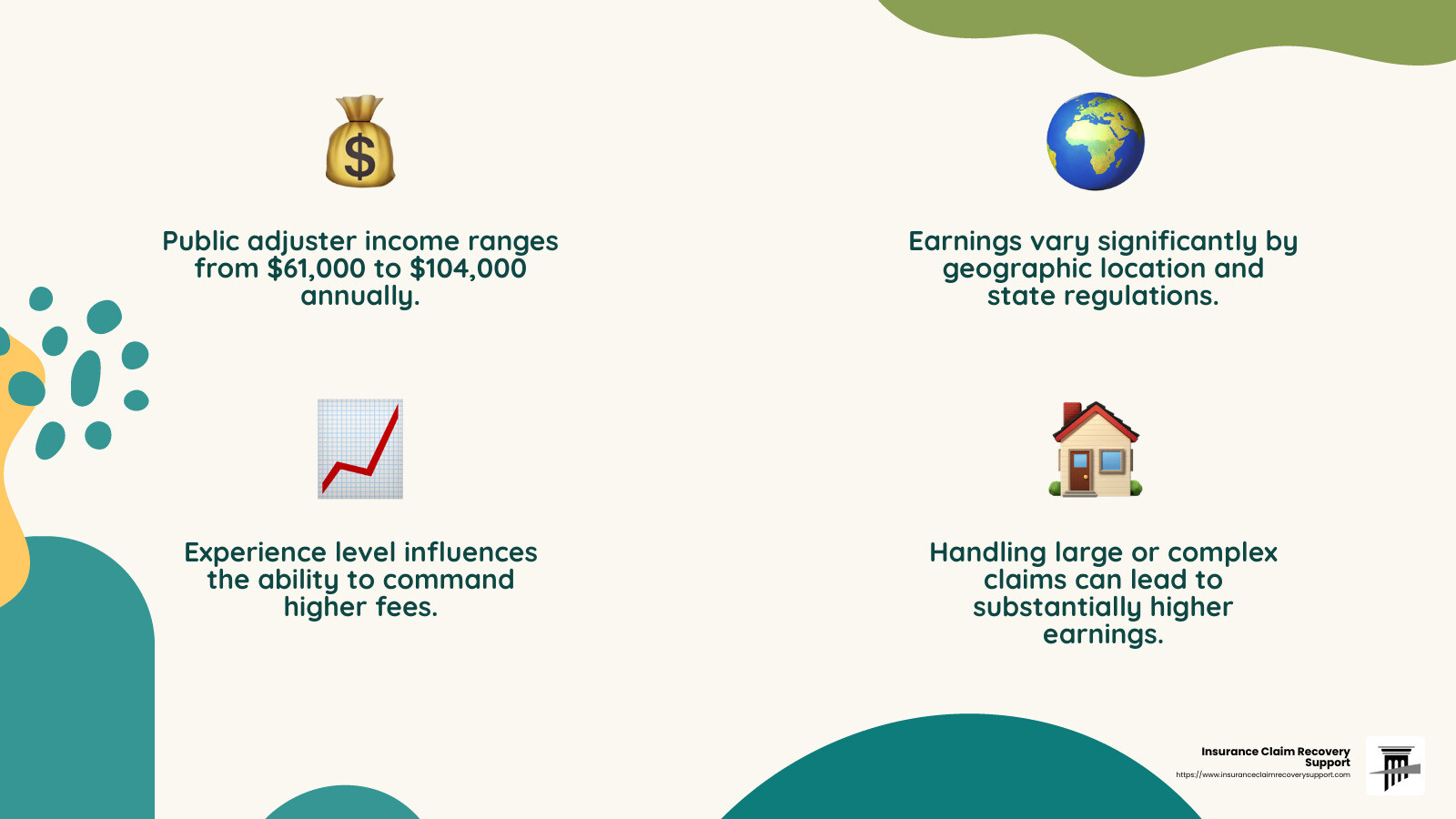
Understanding the Role of a Public Adjuster
When we talk about public adjuster income, it helps to first understand what these professionals actually do. Unlike other insurance professionals, public adjusters stand firmly in your corner during what’s often a stressful and confusing time.
Public adjusters are licensed professionals who exclusively represent policyholders—never insurance companies—throughout the claims process. Think of them as your personal advocate when dealing with property damage from fires, storms, floods, or other covered disasters. Their sole mission is to help you receive every dollar you’re entitled to under your insurance policy.
The insurance world includes several types of adjusters, and the differences between them are crucial:
Public adjusters work only for you, the policyholder. Staff adjusters are employed directly by insurance companies, while independent adjusters are contractors hired by insurers. This distinction matters because it directly affects whose interests they serve—and how they get paid.
As Scott Friedson of Insurance Claim Recovery Support often tells clients, “When you hire a public adjuster, you’re getting someone whose success is measured by your success. Our financial interests are perfectly aligned with yours.”
To become a public adjuster requires significant professional commitment. Each state has its own licensing requirements, typically including rigorous exams, education requirements, continuing education credits, professional liability insurance, and adherence to state regulations. In Texas, for example, adjusters must complete specific coursework and pass a comprehensive exam before receiving their license.
What Does a Public Adjuster Do?
The daily work of a public adjuster revolves around maximizing your claim settlement through several critical activities.
First, they conduct thorough claims assessments, carefully documenting every aspect of your property damage. A good public adjuster leaves no stone unturned, photographing, measuring, and recording all visible and hidden damage.
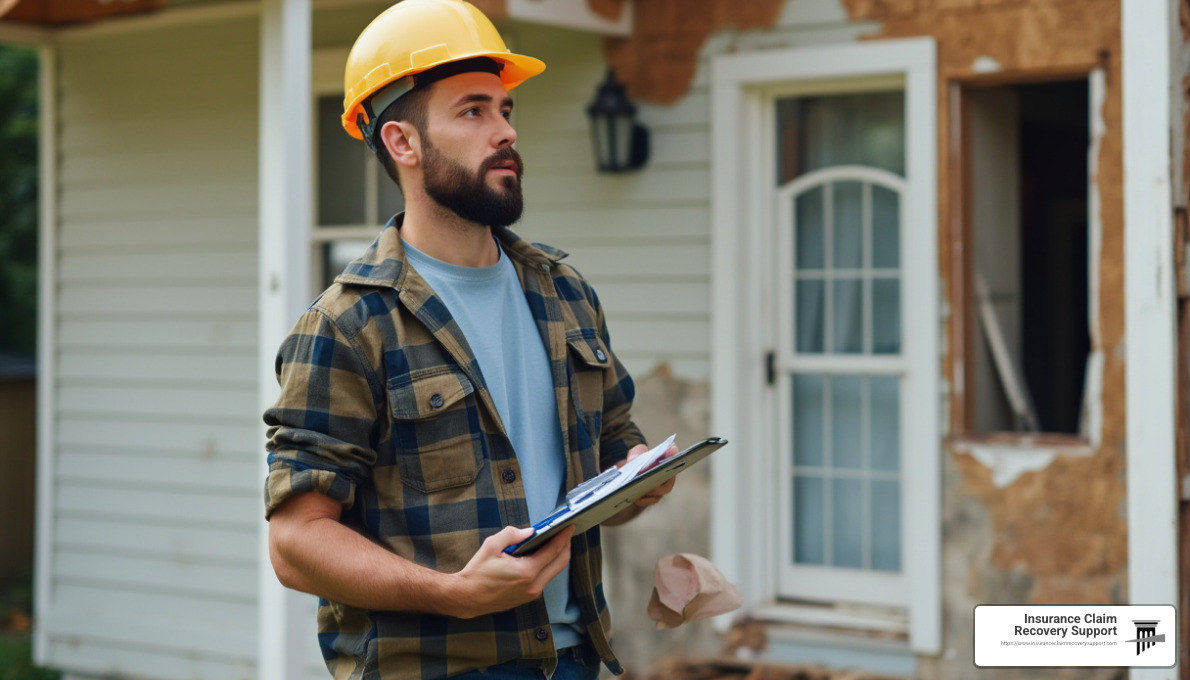
Next comes the policy analysis. Your insurance policy is a complex legal document filled with specific terminology and conditions. Public adjusters are experts at interpreting these documents to identify all applicable coverages—including those you might not even know you have.
The valuation process is where their expertise really shines. Public adjusters create detailed, itemized estimates of your damages and calculate accurate repair or replacement costs. They often collaborate with contractors, engineers, and other specialists to ensure nothing is missed or undervalued.
Once everything is documented, they prepare and submit comprehensive claim packages to your insurance company. These packages include all necessary documentation, supporting evidence, and properly valued estimates.
Perhaps most importantly, public adjusters negotiate directly with insurance companies on your behalf. They use their knowledge of insurance policies, building codes, construction costs, and negotiation techniques to maximize your settlement. This negotiation skill directly impacts both your recovery and their income—creating that perfect alignment of interests.
“Insurance companies have teams of professionals working to minimize their payouts,” explains Friedson. “Shouldn’t you have an expert in your corner working just as hard to maximize yours?”
The effectiveness of a public adjuster in handling these responsibilities not only determines how well you recover from property damage but also directly affects their own compensation. This creates a powerful incentive for them to secure the highest possible settlement for every client they represent—whether in Austin, Dallas, Houston, San Antonio, or anywhere else in Texas.
Factors Influencing Public Adjuster Income
When it comes to public adjuster income, there’s no one-size-fits-all answer. Like many professions, what you can earn depends on a variety of factors that create significant differences in earning potential from one adjuster to another.
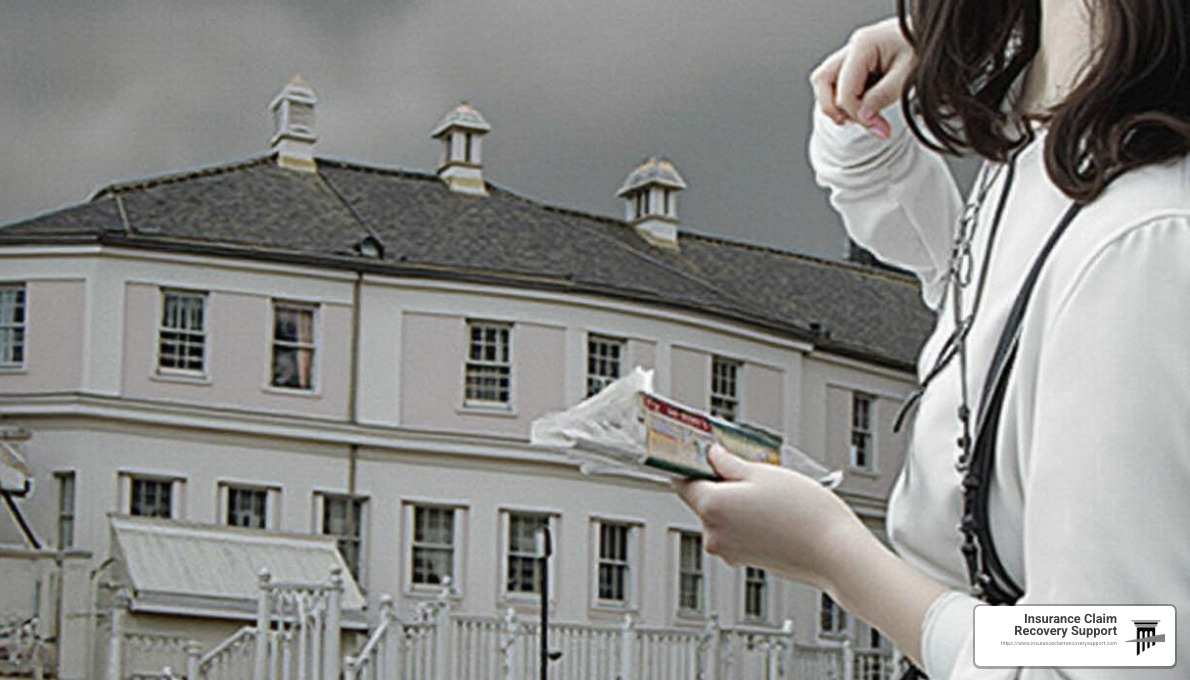
Think of it as a puzzle with multiple pieces – each one contributing to the bigger financial picture. Let’s take a closer look at what really drives income in this profession.
First and foremost, experience matters enormously. Just as you’d expect, those who’ve been in the trenches for years typically command higher fees than newcomers. Public adjusters with more than a decade of experience often earn at the top end of the income range, having proven their ability to handle complex claims and deliver results for policyholders.
Another major factor is specialized expertise. Those who’ve developed deep knowledge in specific niches – like handling commercial property claims or becoming experts in certain types of disasters – typically earn more than generalists. For instance, an adjuster who specializes in complex fire damage claims for manufacturing facilities can often charge premium rates compared to someone handling routine residential water damage.
The size and complexity of claims directly impact earnings too. It’s simple math – larger settlements generally mean larger fees when working on a percentage basis. Commercial claims that might run into millions of dollars can generate substantial income compared to smaller residential claims. This is why many experienced adjusters gradually shift toward more complex, higher-value claims as their careers progress.
Where you work matters tremendously. Geographic location creates significant variations in earning potential. Public adjusters working in coastal areas prone to hurricanes, regions with high wildfire risk, or cities with high property values typically have more opportunities for substantial claims. These areas simply generate more work and higher-value claims than regions with fewer natural disasters or lower property values.
State regulations can put a ceiling on what you can earn. For example, here in Texas, public adjuster fees are capped at 10% of the claim settlement. Florida has a similar structure, limiting fees to 20% for standard claims and 10% for those filed during a declared emergency. Other states have different limitations – or in some cases, no caps at all. These regulatory differences create very real income variations across state lines.
Broader economic conditions play their part too. Construction costs directly affect claim values and settlements. The housing market influences property valuations. Insurance industry trends impact how claims are processed. Even more dramatically, major catastrophic events can create sudden surges in demand for public adjusters, temporarily boosting income opportunities in affected regions.
Impact of Experience and Expertise on Public Adjuster Income
The career path for public adjusters typically follows a clear progression that directly impacts income potential. Most adjusters move through several distinct phases as they build their careers.
In the early years (typically the first three), you’re learning the fundamentals – handling smaller claims, often under supervision, while building client relationships and establishing your reputation. During this period, income usually sits at the lower end of the spectrum as you’re developing your skills and proving yourself.
The middle phase (years four through nine) brings substantial growth. You’re now taking on more complex claims independently, developing specializations, building a referral network, and possibly focusing on specific property types or claim categories. Income typically increases significantly during this phase as your expertise and client base grow.
By the senior level (ten-plus years), the most successful adjusters are handling the industry’s most complex and highest-value claims. Some may be managing other adjusters or have built their own firms. At this stage, deep expertise in specific niches allows them to command premium fees, putting them among the profession’s highest earners.
Certain specialized skills can significantly boost your earning potential as a public adjuster. Commercial property expertise is particularly valuable, as is deep knowledge of specific building systems like HVAC, electrical, or plumbing. Understanding building codes and ordinances gives you an edge in negotiations, as does experience with specific disaster types like hurricanes or wildfires.
Perhaps most valuable is developing expertise in complex business interruption calculations and honing advanced negotiation strategies specific to insurance claims. These higher-level skills separate the top earners from the rest of the field.
As I often tell our team at Insurance Claim Recovery Support, “The most successful public adjusters never stop learning. They invest in continuing education, stay current on building codes and construction costs, and develop specialized knowledge that allows them to handle claims that others simply can’t.”
This commitment to ongoing professional development doesn’t just make you better at serving policyholders – it directly translates to higher public adjuster income throughout your career.
Average Public Adjuster Income in the United States
When it comes to understanding public adjuster income across America, the numbers tell an interesting story. This is a profession with considerable earning potential, though what you’ll actually make can vary quite a bit depending on your situation.
Recent data from 2025 paints a promising picture for those considering this career path. The average public adjuster brings home about $79,211 annually. This typically breaks down to a base salary of around $68,829 plus about $10,381 in additional compensation through commissions and bonuses. Most public adjusters fall somewhere in the income range of $61,000 to $104,000 per year.
These are just averages that include everyone from newcomers to industry veterans. Your actual earnings might look quite different based on your experience, location, and the types of claims you handle.

When compared to their counterparts working directly for insurance companies, public adjusters typically come out ahead financially. Insurance company staff adjusters earn around $64,609 annually (about $31 per hour), while public adjusters average approximately $74,680 per year ($35.90 hourly).
This difference makes sense when you consider the entrepreneurial nature of public adjusting. Rather than receiving a fixed salary, your income directly reflects your performance and the settlements you secure for clients. The most successful public adjusters—especially those handling large commercial or catastrophic claims—can earn well into six figures annually.
According to the Bureau of Labor Statistics, the broader category of claims adjusters shows these wage ranges:
- Entry level (10th percentile): $47,390 annually
- Lower mid-range (25th percentile): $58,770 annually
- Median (50th percentile): $75,050 annually
- Upper mid-range (75th percentile): $91,100 annually
- Top earners (90th percentile): $105,440 annually
Public adjusters who build strong reputations and develop expertise in complex, high-value claims tend to find themselves in those upper earnings brackets.
Public Adjuster Income by State or Region
Where you work plays a huge role in determining your potential public adjuster income. This regional variation comes down to several key factors: state regulations on fees, how often major property damage events occur, local property values, cost of living differences, and how many other adjusters you’re competing with.
Here in Texas, where Insurance Claim Recovery Support is based, public adjusters face a 10% cap on claim settlement fees. Despite this limitation, Texas offers plenty of opportunity for public adjusters because of our frequent severe weather events—hurricanes, hailstorms, and tornadoes—combined with our large population and high property values in major cities.
The income potential varies significantly even within Texas:
In Austin, the booming real estate market and frequent hailstorms create substantial opportunities. With property values so high, even with the 10% fee cap, claims can generate significant income for adjusters.
The Dallas-Fort Worth metroplex experiences its fair share of severe weather, including damaging hailstorms, tornadoes, and flooding. The area’s large population and extensive commercial development ensure a steady flow of claims.
Houston’s vulnerability to hurricanes and catastrophic flooding makes it a hotspot for public adjusters who specialize in water and wind damage claims.
San Antonio may see fewer severe weather events than some other Texas cities, but still provides plenty of work for public adjusters, particularly during hail season.
Smaller Texas cities like Lubbock, San Angelo, Waco, Round Rock, Georgetown, and Lakeway all experience property damage claims requiring public adjuster services, though typically at lower volumes than major metropolitan areas.
Florida represents another high-demand market, with its hurricane exposure and valuable coastal properties. Florida’s fee structure allows public adjusters to charge up to 20% for standard claims and 10% for claims filed during declared emergencies.
Other regions where public adjuster income tends to be higher include coastal areas vulnerable to hurricanes and flooding, regions with wildfire exposure, areas with high property values and construction costs, and states with fewer restrictions on public adjuster fees.
At Insurance Claim Recovery Support, we’ve found that while state regulations certainly influence income potential, the most successful public adjusters find ways to adapt their business approach to thrive wherever they operate. The key is understanding your local market, building strong relationships, and delivering exceptional results for your clients.
How Do Public Adjusters Get Paid?
Understanding how public adjusters get paid provides crucial insight into public adjuster income and explains why these professionals are so motivated to maximize your settlement. Unlike most professionals who charge by the hour or request payment upfront, public adjusters typically work on terms that align their success directly with yours.
The compensation structure for public adjusters is designed to create a true partnership with policyholders—when you win, they win. This arrangement offers peace of mind since you won’t be paying out-of-pocket while waiting for your claim to resolve.
The most common payment method is a contingency fee—a percentage of your final insurance settlement. This percentage typically ranges from 5% to 20%, depending on several factors. For instance, a more experienced adjuster handling a complex commercial claim might charge on the higher end of this range, while a straightforward residential claim might warrant a lower percentage.
As Scott Friedson often tells clients at Insurance Claim Recovery Support, “Our contingency fee structure means we’re fully invested in your success. If we don’t increase your settlement, we don’t get paid—it’s that simple.”
What determines the exact percentage? Several factors come into play:
Claim complexity often influences fees—more complicated claims requiring specialized expertise typically command higher percentages. Timing matters too—engaging a public adjuster before receiving an initial offer from your insurance company might result in a different fee structure than bringing one in after negotiations have already begun.
Experience level naturally affects rates as well. A public adjuster with decades of successful claims and specialized expertise can justify higher fees than someone new to the profession. And of course, state regulations play a major role in determining maximum allowable fees.
While contingency fees are most common, some public adjusters occasionally use alternative payment structures. Flat rates might apply for smaller claims or limited services, providing cost certainty for policyholders. In rare cases, particularly for specialized consulting on complex commercial claims, some may charge hourly rates for specific aspects of claim management.
The timing of payment is straightforward—public adjusters get paid after you receive your settlement. This arrangement ensures they remain motivated to secure not just the largest possible settlement, but also the fastest resolution of your claim.
State Regulations on Public Adjuster Fees
State regulations significantly impact public adjuster income by establishing caps on what these professionals can charge. These consumer protection measures ensure public adjusters earn fair compensation while policyholders retain the majority of their settlements.
In Texas, where Insurance Claim Recovery Support operates, public adjuster fees are capped at 10% of the claim settlement. This Texas Department of Insurance regulation creates a balanced approach—public adjusters can earn a reasonable income while policyholders keep 90% of their settlements.
Florida takes a different approach with a two-tier system. Public adjusters can charge up to 20% for standard claims, but during declared emergencies (like after a hurricane), fees are capped at 10% to prevent price gouging when policyholders are most vulnerable.
Other states maintain their own specific regulations:
– Some have no caps but require clear fee disclosure
– Others limit fees between 10-15% of settlements
– A few use sliding scales where larger claims have lower percentage fees
An important detail many policyholders don’t realize: these percentage caps apply to the total settlement amount, not just the increase above the insurance company’s initial offer. This makes hiring a public adjuster early in the process—before any initial offer—particularly advantageous.
For example, if your claim settles for $100,000 with a public adjuster’s help in Texas, their fee would be $10,000 regardless of whether the insurance company initially offered $50,000 or nothing at all. This structure incentivizes public adjusters to maximize the entire claim value from the beginning.
After your property damage claim is settled, there are important steps to ensure proper recovery and prevent future issues. More info about Steps to Take After a Property Damage Insurance Claim is Settled
The fee structure explains why public adjusters are selective about which claims they accept. They need confidence that their involvement will significantly increase your settlement—enough to justify their fee while still leaving you better off than handling the claim yourself.
Comparing Public Adjuster Income to Other Adjusters
When you look at the insurance industry landscape, understanding how public adjuster income stacks up against other adjusters helps paint a clearer picture of this career path. The differences aren’t just about who these professionals work for—they fundamentally impact how much they earn and their financial stability.
The insurance world has three main types of claims adjusters, each with their own distinct payment structures:
Staff Adjusters work directly for insurance companies, earning a steady annual salary averaging around $64,609. They enjoy the comfort of predictable paychecks, comprehensive benefits packages, and potential performance bonuses. What they gain in stability, they sacrifice in earning potential—their income generally has a defined ceiling regardless of how well they perform.
Independent Adjusters fall somewhere in the middle. Though they contract with insurance companies rather than policyholders, they aren’t salaried employees. They typically earn fees per claim based on predetermined schedules. When disaster strikes—hurricanes, wildfires, or major flooding—their income can surge dramatically as they handle multiple catastrophic claims. However, during quieter periods, their earnings may dip significantly.
Public Adjusters have perhaps the most variable income structure. Working exclusively for policyholders, they typically earn a percentage of the final claim settlement—usually between 5% and 20%, depending on state regulations and claim complexity. This creates a direct link between their success in maximizing settlements and their own earnings. While they generally don’t receive company benefits (unless they provide them for themselves), their earning potential on large claims far exceeds what most staff adjusters could ever make.
This fundamental difference—steady salary versus performance-based commission—creates dramatically different financial landscapes for these professionals.
Which Adjusters Make the Most Money? Comparing Public Adjuster Income
The earnings race between different types of adjusters shifts depending on where they are in their careers:
For newcomers to the industry, staff adjuster positions often provide higher guaranteed starting income, making them attractive entry points. The steady paycheck and training opportunities help build foundational skills without financial stress.
As careers progress, experienced public adjuster income often outpaces what staff adjusters make, particularly for those who develop specialized expertise. A public adjuster who becomes known for handling complex commercial property claims or specialized disaster recovery can significantly increase their earning potential.
At the highest end of the spectrum, two types of adjusters typically earn the most: public adjusters managing large commercial claims and independent adjusters who chase catastrophic events across multiple states.
“Independent adjusters who work on catastrophic claims have the potential to earn over $100,000 in a year.” This is especially true for those who maintain licenses in multiple states, allowing them to follow disaster events wherever they occur—from hurricane season in Florida to wildfire season in California.
For public adjusters with established practices focusing on complex commercial claims, the income potential can be even more substantial. At Insurance Claim Recovery Support, we’ve seen that even with Texas’s 10% fee cap, public adjusters handling multi-million dollar commercial claims can earn impressive incomes because of the sheer size of these settlements.
What separates the highest earners from average performers? Several key factors stand out:
Specialization makes a tremendous difference. Adjusters who develop deep expertise in specific high-value claim types—like commercial fire damage or hurricane destruction of apartment complexes—can command higher fees and attract more lucrative cases.
Geographic flexibility allows adjusters to work where they’re most needed. Being willing and able to travel to disaster-affected areas can dramatically increase income opportunities.
Business development skills matter enormously. The best-paid public adjusters build strong referral networks through satisfied clients, attorneys, and contractors, ensuring a steady stream of new claims.
Negotiation expertise directly impacts a public adjuster’s bottom line. Those who consistently secure substantially higher settlements than insurance companies initially offer naturally earn more through their percentage fees.
Efficiency in managing multiple claims simultaneously allows top-performing adjusters to increase their annual income without sacrificing quality of service.
For those considering public adjusting as a career, it’s worth noting that while the income ceiling is virtually unlimited, success requires significant investment in education, licensing, marketing, and reputation-building. The highest earners typically spend years developing their expertise and professional networks before reaching premium income levels.
At Insurance Claim Recovery Support, we’ve found that adjusters who genuinely focus on policyholder advocacy—rather than just maximizing their own fees—tend to build more sustainable practices with stronger long-term income potential. When you help people recover fully from disasters, word spreads quickly.
For more information about negotiating with insurance adjusters for property damage, visit the Insurance Information Institute for helpful resources and guidance.
Potential Earnings on Large or Complex Claims
When it comes to public adjuster income, handling large or complex claims represents the gold standard for earning potential in this profession. These high-value cases can transform a good year into an exceptional one for public adjusters who have developed the expertise to manage them effectively.
Large claims typically involve substantial commercial properties, multi-family residential complexes, industrial facilities, historic buildings, or properties with extensive specialized damage. The financial rewards for handling these claims can be significant.
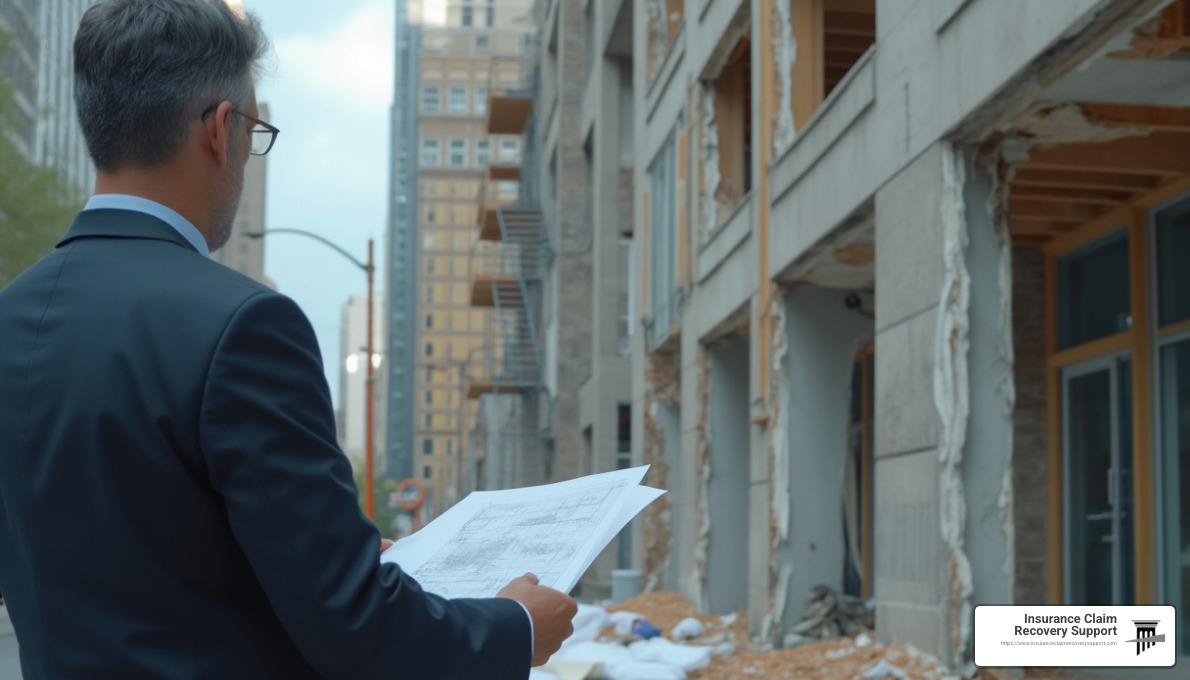
To put this in perspective, imagine working on a commercial property claim that settles for $1,000,000. In Texas, where our fee is capped at 10%, that single claim would generate $100,000 in income. In states without such caps, the earnings potential could be even higher depending on the negotiated fee percentage. One large commercial claim can sometimes equal the income from dozens of smaller residential claims.
Catastrophic events create unique income opportunities for public adjusters. After Hurricane Harvey devastated Houston in 2017, our team at Insurance Claim Recovery Support handled multiple large commercial and multi-family claims simultaneously. We not only helped business owners and property managers steer their complex insurance recoveries but also experienced one of our most productive income periods.
“Complex commercial claims are like puzzles with million-dollar pieces,” says Scott Friedson. “The adjusters who know how to put those pieces together correctly can deliver tremendous value to clients while earning substantial fees in the process.”
Several factors make these large claims particularly lucrative:
The percentage-based fee structure means larger settlements naturally generate larger fees. A public adjuster earning 10% on a $2 million commercial claim makes significantly more than on a $200,000 residential claim, while often requiring a similar time investment.
Experienced adjusters can substantially increase settlements on complex claims by identifying overlooked coverages or damages. When you help a client recover an additional $500,000 that would have been missed, your percentage-based fee becomes much more valuable to both parties.
Specialized knowledge commands premium fees. Understanding complex issues like business interruption calculations, code compliance requirements, or specialized equipment valuation allows public adjusters to handle claims that others simply can’t.
Multi-state licensing creates tremendous opportunities during disaster seasons. Public adjusters licensed across multiple states can follow catastrophic events, maximizing their earning potential when demand spikes.
It’s worth noting that these lucrative opportunities don’t fall into just anyone’s lap. They typically go to public adjusters who have invested years in building proven track records, developing specialized expertise, nurturing professional networks, and establishing excellent reputations for claim handling. You also need the financial capacity to sustain operations during what can be lengthy claim processing periods.
For aspiring public adjusters, developing the skills necessary to handle these complex claims represents the clearest path to maximizing income potential in this profession. While the learning curve may be steep, the financial rewards for those who master these complexities can be substantial.
Benefits and Challenges of Public Adjuster Income Structure
Working as a public adjuster offers a unique financial structure that comes with both remarkable advantages and notable challenges. This distinctive approach to compensation shapes not just how public adjusters earn their living, but also how they approach their work with clients.
Benefits of the Public Adjuster Income Structure
The percentage-based fee model creates a beautiful alignment between public adjusters and the people they serve. When your success directly determines my paycheck, you can be confident I’m giving your claim my absolute best effort.
This natural partnership is perhaps the greatest strength of public adjuster income structures. Since adjusters only get paid when their clients receive settlements, and typically earn a percentage of those settlements, both parties share the same goal: maximizing the recovery amount. It’s a refreshing change from the inherent conflicts that can exist in other professional relationships.
The sky’s the limit when it comes to earning potential in this field. Unlike the predictable but capped earnings of a salaried position, successful public adjusters can achieve substantial incomes, especially during active disaster seasons or when handling large commercial claims. Those who build expertise in complex commercial properties can see particularly impressive returns.
Your compensation truly reflects your skill and effort in this profession. Public adjusters who consistently deliver outstanding results build reputations that attract more clients with larger claims, creating a positive cycle of success and higher earnings. The better you serve your clients, the better you do financially – exactly how business should work.
The entrepreneurial aspect of being a public adjuster gives you significant control over your financial destiny. You choose which claims to take, set your fee structure (within regulatory limits), and determine your business development approach. This freedom allows you to build a practice that matches your financial goals and lifestyle preferences.
As business owners rather than employees, public adjusters also benefit from tax advantages that can significantly impact their bottom line. The ability to deduct legitimate business expenses often results in a more favorable tax situation than what traditional employees experience.
Challenges of the Public Adjuster Income Structure
The flip side of unlimited earning potential is the reality of income uncertainty. Public adjuster income can fluctuate dramatically based on factors largely outside your control – primarily the frequency and severity of property damage events in your region. One month might bring multiple lucrative claims, while the next might be unsettlingly quiet.
The timing of payment presents another significant challenge. Unlike most professionals who invoice and receive payment shortly after providing services, public adjusters typically wait until claims are fully settled before receiving compensation. For complex cases, this can mean waiting months or even years for payment on work you’re doing today.
“Having worked through hundreds of complex claims,” shares Scott Friedson of Insurance Claim Recovery Support, “I’ve learned that financial planning becomes as important as claim handling expertise. You need to prepare for the feast-or-famine nature of this business.”
State regulations can also limit earning potential. In Texas, for example, the 10% cap on fees means that even if you put extraordinary effort into a smaller claim, your compensation is strictly limited. This can make some claims less financially viable despite the policyholder’s genuine need for assistance.
Unlike staff adjusters who receive company-provided benefits, public adjusters shoulder all their business costs personally. These expenses add up quickly: licensing fees in multiple states, continuing education requirements, marketing costs, office space, travel expenses, and professional liability insurance all cut into gross income.
The absence of employer-provided benefits represents another financial consideration. Public adjusters must arrange and pay for their own health insurance, retirement planning, and other benefits typically included in traditional employment packages.
At Insurance Claim Recovery Support, we’ve found that successful public adjusters develop practical strategies to steer these challenges. Building substantial financial reserves helps weather slower periods. Diversifying across different claim types and client sources creates more stable income streams. Creating efficient systems allows for managing multiple claims simultaneously, while investing in education enables handling of more complex, higher-value claims.
The public adjusting profession rewards those who balance entrepreneurial business management with technical expertise in claim handling. Those who master both aspects typically achieve the most stable and substantial incomes in this rewarding but demanding field.
For anyone considering this career path, honestly evaluate these benefits and challenges. While the income potential is genuinely impressive, success requires resilience, business savvy, and comfort with financial uncertainty that not everyone possesses.
Frequently Asked Questions about Public Adjuster Income
What Percentage Do Public Adjusters Charge?
When it comes to public adjuster income, one of the most common questions I hear from property owners is about fee percentages. Public adjusters typically charge between 5% and 20% of the final insurance settlement, but several factors influence where your specific case might fall on this spectrum.
State regulations play a significant role in determining these fees. Here in Texas, where our team at Insurance Claim Recovery Support operates, state law caps public adjuster fees at 10% of the claim settlement. Florida has a different approach, allowing up to 20% for standard claims but reducing that to 10% during declared emergencies when property damage is widespread.
The size and complexity of your claim also matter. For larger commercial claims, you might see adjusters willing to work for a lower percentage since the overall settlement value is higher. Conversely, smaller claims might command a higher percentage to ensure the adjuster is fairly compensated for their time and expertise.
Timing can also affect the fee structure. If you bring in a public adjuster early in the process, before any offers have been made, you might secure a more favorable rate than if you seek help after initial negotiations have already begun.
While these fees are important to consider, I always remind property owners to focus on the net result. Our team operates within the 10% Texas cap, and we’ve found that our clients typically receive settlements that are substantially higher than what they might have secured on their own—often 30% or more—even after our fee is deducted.
How Does Hiring a Public Adjuster Affect My Claim Payout?
The short answer is that hiring a public adjuster typically results in a significantly higher claim payout, even after accounting for their fee. This boost in settlement amounts happens for several important reasons.
First, public adjuster income is directly tied to your settlement amount, creating a perfect alignment of interests. We only succeed when you succeed, which drives us to maximize your recovery. Our team at Insurance Claim Recovery Support approaches each policy with a fine-tooth comb, identifying coverages and entitlements that property owners often miss when handling claims themselves.
Public adjusters bring expertise in comprehensive damage documentation, catching items that might otherwise go unnoticed. We use industry-standard valuation methods to ensure you receive fair compensation for everything from structural damage to business interruption losses.
The negotiation process is where a professional adjuster truly shines. We understand insurance company tactics and have the experience to counter arguments designed to minimize payouts. This expertise often makes a substantial difference in the final settlement amount.
Research supports this value proposition. Studies have shown that homeowners working with public adjusters received payouts averaging $22,266, compared to just $18,659 for those handling claims themselves—a difference of nearly 20%. Even after accounting for the adjuster’s fee, policyholders typically come out ahead.
When you’re facing the stress of property damage, having a professional in your corner who knows how to negotiate with insurance adjusters can be invaluable. If you’re wondering about specific negotiation strategies, we’ve put together a detailed guide on How to Negotiate with Insurance Adjuster for Property Damage.
Are Public Adjuster Fees Negotiable?
Yes, public adjuster fees are often negotiable, though any discussion must stay within the boundaries of state regulations. While we and other public adjusters typically have standard fee structures, there’s usually room for conversation based on your specific situation.
Larger claims may warrant discussion of a lower percentage fee, as the overall dollar amount will still provide fair compensation for the adjuster’s work. The complexity of your claim also factors in—some property damage scenarios require specialized expertise that may influence the fee structure.
If you’re a property manager with multiple properties or a business owner with several locations that might need services, this could also affect fee negotiations. Market conditions matter too—during major disaster events when public adjusters are in high demand, there might be less flexibility than during quieter periods.
At Insurance Claim Recovery Support, we believe in transparent conversations about our compensation. I always recommend focusing on value rather than simply trying to minimize the percentage. An experienced adjuster charging 10% who increases your settlement by 40% provides much more value than someone charging 5% who only increases it by 10%.
When discussing fees with a public adjuster, make sure everything is clearly documented in your contract. Understand exactly what services are included, and don’t hesitate to ask questions about the payment timing and process. Know your state’s regulations regarding fee caps—this information empowers you in any negotiation.
Public adjuster income is entirely performance-based. We don’t get paid unless you get paid, and our fee comes from the settlement we help secure. This creates a natural incentive for us to work diligently on your behalf, striving for the maximum possible recovery under your policy.
Conclusion
Understanding public adjuster income opens a window into both the profession itself and the significant value these advocates bring to the insurance claims process. Throughout our exploration, we’ve seen that public adjusters can earn substantial incomes, especially when they develop specialized expertise in complex or high-value claims.
When we look at the complete picture of public adjuster income, several important patterns emerge:
Public adjusters typically earn between $61,000 and $104,000 annually, with the average hovering around $79,211. However, this range doesn’t tell the whole story. Top performers who handle large commercial claims or work in areas frequently hit by natural disasters often earn considerably more, sometimes exceeding six figures by a significant margin.
The contingency-based payment structure creates a natural alignment between public adjusters and the policyholders they represent. By earning a percentage (typically 5-20%) of the final insurance settlement, public adjusters succeed only when their clients do. This creates a powerful incentive to maximize claim values and fight for every dollar a policyholder deserves.
Geographic location plays a crucial role in earning potential. A public adjuster working in hurricane-prone coastal Texas faces different opportunities than one working in areas with fewer natural disasters. State regulations, local property values, and the frequency of damaging events all contribute to these regional differences.
Experience and specialization command a premium in this field. Seasoned public adjusters who have developed expertise in specific claim types attract more lucrative cases and can often negotiate better fees, creating a clear path for income growth as their careers advance.
Despite the fees they charge, public adjusters frequently secure settlements significantly higher than what policyholders might obtain on their own. This creates a win-win scenario where both the adjuster and the policyholder benefit from professional representation.
For property owners weighing whether to hire a public adjuster, understanding this compensation structure helps clarify the motivation behind these professionals. The contingency fee ensures your adjuster is deeply invested in maximizing your settlement – their paycheck literally depends on getting you the best possible outcome.
At Insurance Claim Recovery Support, we take pride in helping property owners throughout Texas recover from fire, hail, hurricane, tornado, and other covered property damage. Our work spans Austin, Dallas, Fort Worth, San Antonio, Houston, Lubbock, San Angelo, Waco, Round Rock, Georgetown, Lakeway, and beyond. Our commitment to policyholder advocacy drives everything we do, and we measure our success by the fair settlements we secure for our clients.

For property owners facing the daunting challenge of navigating an insurance claim, partnering with a professional public adjuster can transform a potentially frustrating experience with an inadequate settlement into a fair, comprehensive recovery. While public adjusters do earn fees for their services, the value they provide typically far exceeds their cost, making them essential allies during what is often a stressful and confusing process.
If you’re dealing with property damage and want to ensure you receive every dollar you’re entitled to under your policy, consider reaching out to a licensed public adjuster. More info about Public Adjuster Services
When it comes to insurance claims, having an expert on your side who is financially motivated to maximize your recovery creates a powerful advantage. The income structure of public adjusters ensures their success directly mirrors yours—a perfect alignment that benefits policyholders during what is often one of the most challenging experiences they face.


